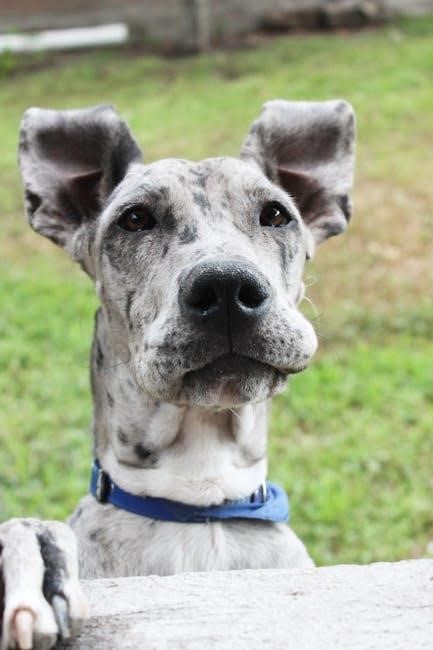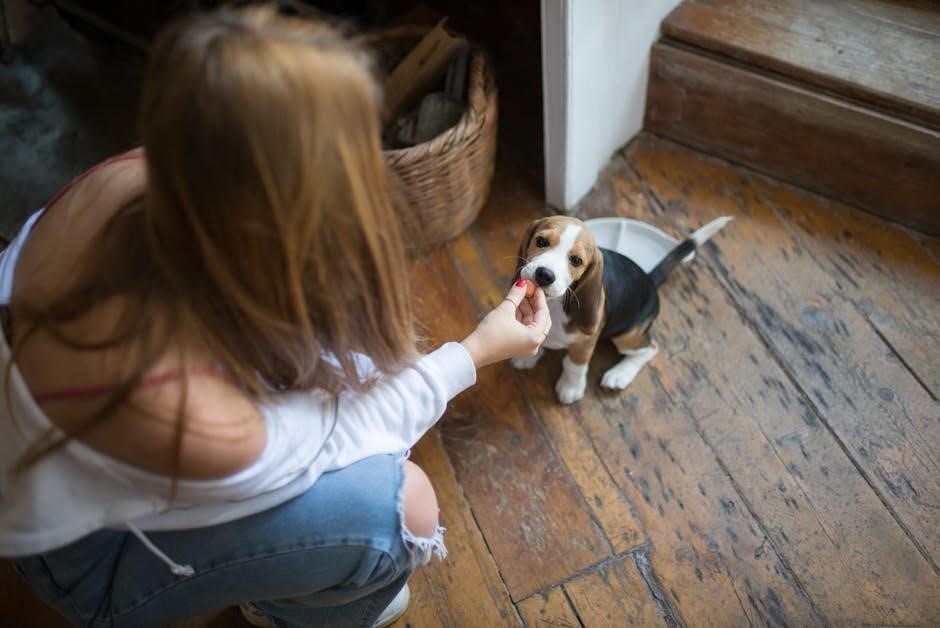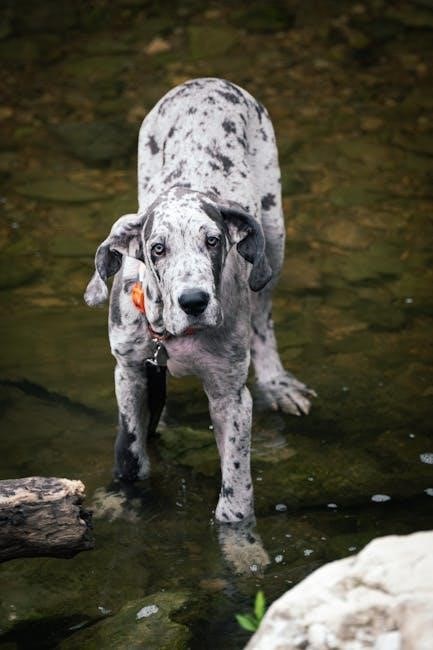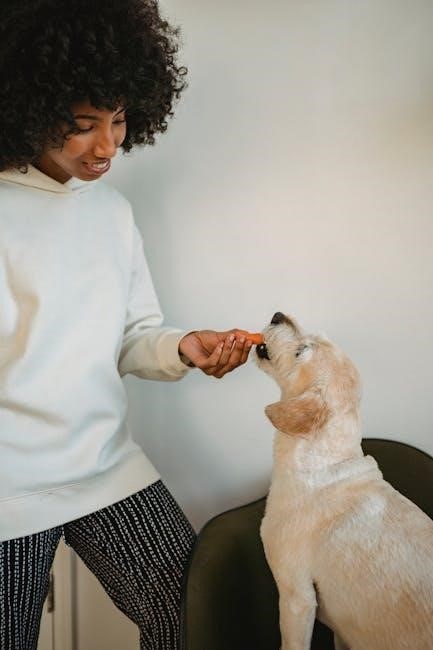Feeding Great Dane puppies requires careful attention to their rapid growth and specific nutritional needs. Proper feeding practices ensure healthy development and prevent potential health issues. This guide provides essential insights and recommendations for raising a thriving Great Dane puppy‚ covering everything from food selection to portion control and feeding schedules.

Great Dane Puppy Feeding Chart
Great Dane puppies require 2-4 cups daily at 2 months‚ increasing to 6-10 cups by 8-12 months. Adjust portions based on size‚ gender‚ and growth rate.
Age-Specific Feeding Guidelines
Great Dane puppies grow rapidly‚ requiring tailored feeding schedules based on age. From 2 months‚ puppies need 2-4 cups daily‚ divided into 3 meals. By 3 months‚ increase to 3-5 cups‚ and at 4-6 months‚ 4-6 cups. From 6 to 8 months‚ feed 5-7 cups‚ and by 8-12 months‚ 6-10 cups. Each puppy’s growth rate and activity level may vary‚ so monitor and adjust portions accordingly. Avoid overfeeding to prevent health issues like bloat. Consult a vet for personalized advice to ensure optimal growth and health throughout these critical developmental stages.
Adjusting Portions by Puppy Size and Gender
Great Dane puppies’ food portions should be adjusted based on size and gender to support healthy growth. Male puppies typically require slightly more food than females‚ especially as they mature. For example‚ a male puppy may need 6-10 cups daily‚ while females require 6-8 cups. Larger or more active puppies may need higher portions‚ while smaller or less active ones may need less. Monitoring growth and adjusting meal sizes ensures optimal development. Avoid overfeeding to prevent obesity and joint issues. Consult a veterinarian for personalized portion recommendations tailored to your puppy’s specific needs and activity level.


Dietary Requirements for Great Dane Puppies

Great Dane puppies need a balanced diet rich in high-quality protein from sources like chicken or beef‚ along with balanced fats for energy and skin health. Proper levels of calcium and phosphorus support bone growth without over-supplementation.
High-Quality Protein Sources
Feeding Great Dane puppies requires high-quality protein sources to support their rapid growth and muscle development. Animal-based proteins like beef‚ chicken‚ turkey‚ lamb‚ duck‚ eggs‚ and fish are ideal. These ingredients provide essential amino acids for tissue repair and energy. Avoid low-quality fillers and by-products‚ as they lack nutritional value. Protein-rich diets help maintain lean muscle mass and support overall health; Ensure the food is specifically formulated for large breeds to meet their unique needs. Consult your veterinarian to choose the best protein sources for your puppy’s optimal growth and development. Proper protein intake is crucial for a healthy‚ thriving Great Dane puppy.
Importance of Balanced Fat Content
Balanced fat content is crucial for Great Dane puppies to support energy needs and overall health. Fats provide essential calories for growth and help absorb vitamins. High-quality sources like chicken‚ salmon‚ or eggs ensure optimal nutrition. Excessive fat can lead to obesity and joint issues‚ while too little may cause energy deficiencies. Aim for a fat content of 12-15% in their diet to maintain a healthy balance. Proper fat intake supports skin health and digestion‚ ensuring your puppy develops into a strong‚ thriving adult. Avoid low-quality fillers and ensure fats come from named animal sources for the best results. Balanced fat content is vital for their well-being.

Feeding Schedule for Great Dane Puppies
Great Dane puppies should be fed 3-4 times daily until 9 months old‚ then 2 meals daily thereafter. Divide their daily ration evenly and provide fresh water always.
Frequency of Meals
Great Dane puppies require multiple meals daily to support their rapid growth. Puppies under 9 months should be fed 3-4 times a day‚ divided into equal portions. This frequent feeding prevents overeating and reduces the risk of bloat. As they mature‚ around 9-12 months‚ the frequency can gradually decrease to 2-3 meals daily. Consistency in meal times helps establish a routine and ensures optimal digestion. Avoid feeding right before heavy exercise or play to minimize health risks. Always provide fresh water alongside meals to keep your puppy hydrated and comfortable.
Portion Control and Feeding Times
Portion control is vital to prevent overfeeding and promote healthy growth. Great Dane puppies should start with smaller portions and gradually increase as they grow. Feed 2-4 cups daily for puppies under 3 months‚ divided into 3-4 meals. For 6-12 months‚ 4-6 cups daily in 2-3 meals suffice. Avoid feeding close to heavy exercise to reduce bloat risk. Stick to consistent feeding times‚ such as morning‚ noon‚ and evening‚ and adjust portions based on growth and activity. Monitor your puppy’s weight and consult a vet if unsure. Proper portion control ensures a balanced diet and supports overall health‚ preventing obesity and joint issues. Consistency and moderation are key to raising a healthy Great Dane. Adjust feeding times and portions as your puppy matures to maintain optimal health and development.

Special Considerations in Feeding
Special considerations include preventing bloat by avoiding heavy meals before exercise and ensuring regular‚ balanced feeding to support healthy growth and digestion in your Great Dane puppy;
Avoiding Growth-Related Issues
Avoiding growth-related issues in Great Dane puppies is crucial due to their rapid development. Overfeeding or underfeeding can lead to joint problems and other health complications. Ensuring a balanced diet with proper protein and fat content helps maintain steady growth. Feeding smaller‚ frequent meals prevents bloat and supports digestion. Regular monitoring of weight and growth rate is essential to adjust portions accordingly. Avoid high-calorie treats and ensure exercise is moderate during feeding times. Consult a veterinarian to tailor feeding plans for optimal growth and to prevent conditions like hip dysplasia and other skeletal issues common in large breeds.
Managing Digestion and Stool Quality
Managing digestion and stool quality is vital for Great Dane puppies to ensure optimal health. A high-quality‚ balanced diet rich in fiber and essential nutrients supports healthy digestion. Avoid overfeeding‚ as this can lead to digestive discomfort and loose stools. Incorporating natural treats like carrots or apples can aid digestion without disrupting the diet. Ensure fresh water is always available to prevent dehydration and promote healthy stool formation. Monitoring stool consistency helps identify potential issues early. A consistent feeding schedule and portion control also play a key role in maintaining digestive health. Proper digestion is essential for nutrient absorption and overall growth.

Best Food Types for Great Dane Puppies
Great Dane puppies thrive on high-quality‚ nutrient-rich foods designed for large breeds. Look for puppy food with high-quality animal-based protein sources like chicken‚ beef‚ or turkey. Balanced fat content is essential for energy and growth. Avoid fillers and by-products‚ opting instead for whole grains like brown rice or oats. Large-breed specific formulas are recommended to support joint health and controlled growth rates. Wet food can be added to enhance palatability and hydration. Consult your veterinarian to determine the best food for your puppy’s specific needs‚ ensuring a well-rounded diet that promotes healthy development and prevents growth-related issues.

Healthy Treat Options for Great Dane Puppies
Great Dane puppies can enjoy healthy‚ low-calorie treats that complement their diet without overfeeding. Carrots‚ apples‚ and berries are excellent choices‚ providing vitamins and fiber without excessive calories. Hard vegetables like carrots also help maintain dental health. Small portions of plain‚ unflavored yogurt or cottage cheese offer probiotics for digestion. Cooked‚ boneless chicken or turkey can be given sparingly as a protein-rich reward. Avoid high-sugar or salty snacks‚ as well as anything toxic like chocolate or onions. Treats should make up less than 10% of their daily calorie intake to prevent weight gain. Always introduce new treats slowly to monitor for any digestive issues.

Monitoring Growth and Adjusting Diets
Regularly monitoring your Great Dane puppy’s growth is crucial to ensure they are developing healthily. Track their weight‚ height‚ and body condition weekly‚ adjusting their diet as needed. Puppies grow rapidly‚ requiring consistent nutrient intake. Overfeeding can lead to obesity and joint issues‚ while underfeeding may stunt growth. Use a growth chart to compare your puppy’s progress with breed standards. Adjust portion sizes based on age and activity level‚ ensuring a balanced diet. Transition from puppy to adult food gradually around 18 months to prevent digestive upset. Consult your veterinarian for personalized advice to maintain optimal health and development throughout their growth stages.
Feeding a Great Dane puppy requires careful planning to support their rapid growth and overall health. By following a structured feeding schedule‚ selecting high-quality foods‚ and monitoring their development‚ you can help your puppy thrive. Avoid overfeeding to prevent obesity and joint issues‚ and ensure meals are balanced to meet their nutritional needs. With consistent care and attention‚ your Great Dane will grow into a strong‚ healthy adult. Always consult a veterinarian for personalized advice tailored to your puppy’s unique needs‚ ensuring they receive the best possible start in life.

